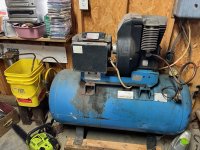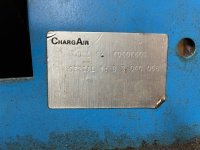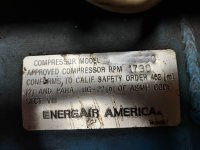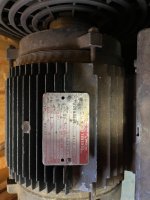Just found this great thread. Lots of lamenting older USA made compressors, and one thing I didn't see mentioned was how much quieter the ones from 60 years ago are, versus anything made in the last 30-40 years. It seems like all of the manufacturers went to smaller displacement compressors at higher RPM on their larger tanks, sometime in the 1980's, and now they're all loud enough to startle the hell out of anyone when they fire up in the middle of the day. Most of the compressors from the 1960's just huffed along, slow and quiet, by comparison.
Of course, tank rot and safety is a major issue on anything real old, and most don't want the expense or trouble of having the tank checked for pitting or thickness, or having it re-pressure tested.
I have a 30 year old 60 gallon 7 hp C-H Industrial, although the FLA = 15A @ 240V 1Ø cap run induction motor tells me it's really just 3 hp... a victim of the creative spec'manship in which all motor manufacturers have played the last 30-40 years. It does 10 - 12 CFM over the useable pressure range, plenty enough for all of my air tools, painting, and even sandblasting... yeah, it runs hard during sandblasting. Like anything built after 1980, it's louder than I'd like, but not nearly as bad as most built today.
No one has been talking about air line treatment, and some of the rigs I've seen here could really benefit from more than a hose plugged into a tank. I'm actually re-plumbing the air lines in my shop now:
- 3/4" hose from tank to 3/4" copper type L hard line
- 3/4" Cu type L up to joist bay in ceiling
- Tees off to 3 parallel 1/2" Cu type L spaced within a joist bay
- 14 feet run of 3x 1/2" runs from compressor in corner of shop to hose rack in middle of shop, and provides air cooling for better separator performance
- Tees back into 1x 3/4" manifold
- 3/4" run down to regulator and separator, with tee off an additional 1/2" line to run upstairs
- Multiple 3/8" AT and 1/4" IM female quick couplings
- Second 1/2" regulator and separator upstairs, for small blast cabinet, or misc. usage with single 1/4" IM coupling
The name of the game is "cooling", when trying to separate water and oil out of a line. I see too many put their separator right onto the hot tank fitting, no thermal gap and no chance for the air to cool. Then they wonder why they have water shooting out of their air ratchet exhaust, or crinkling paint from HVLP. Water will only condense out of the air after cooling, and preferably after any major pressure drops (eg. regulator), as the pressure drop causes further cooling and condensation. This is why I'm running three parallel 1/2" lines, rather than just a single 3/4", and why you should always install a separator
downstream of the regulator.
The large line size is not for continuous capacity, you can push 10 - 12 CFM thru a much smaller line with acceptable pressure drop, but it gives a better impulse capacity for tools that draw a lot of air for a short burst of time.



